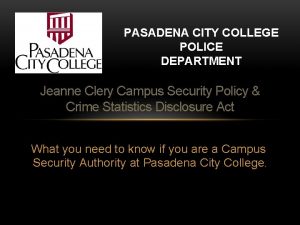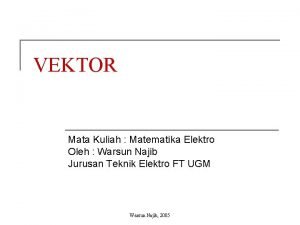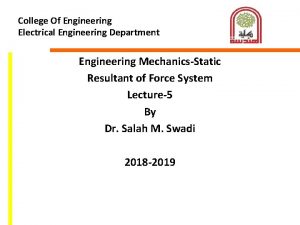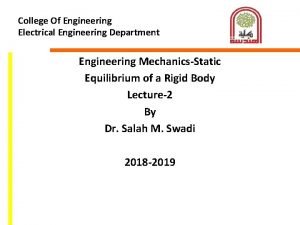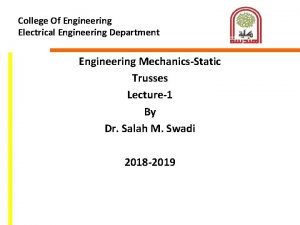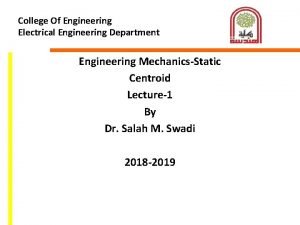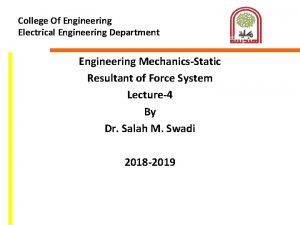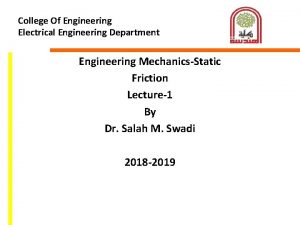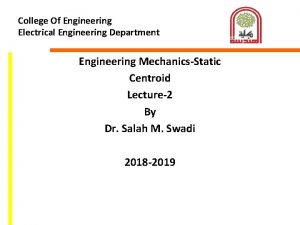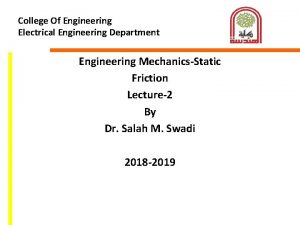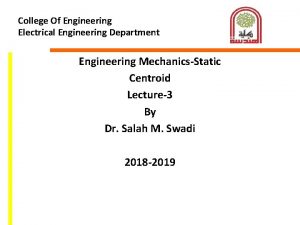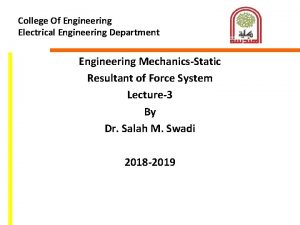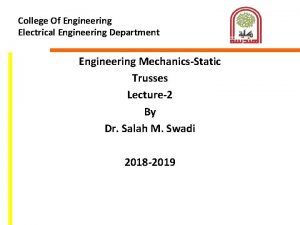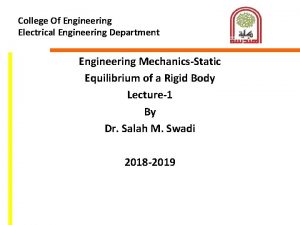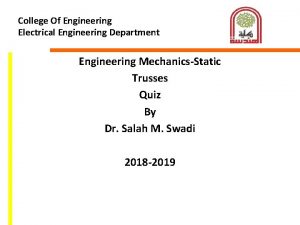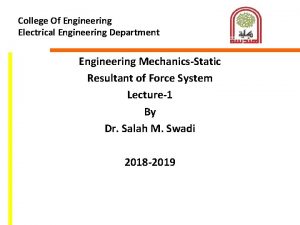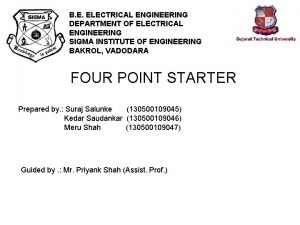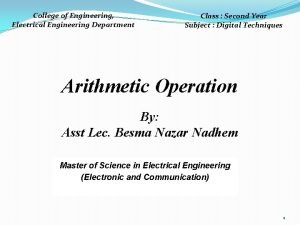College Of Engineering Electrical Engineering Department Engineering MechanicsStatic


















- Slides: 18

College Of Engineering Electrical Engineering Department Engineering Mechanics-Static Friction Lecture-1 By Dr. Salah M. Swadi 2018 -2019

Chapter Objectives • Introduce the concept of dry friction • To present specific applications of frictional force analysis on wedges, screws, belts, and bearings • To investigate the concept of rolling resistance

Chapter Outline 1. 2. 3. 4. 5. 6. Characteristics of Dry Friction Problems Involving Dry Friction Wedges Frictional Forces on Screws Frictional Forces on Flat Belts Frictional Forces on Collar Bearings, Pivot Bearings, and Disks 7. Frictional Forces on Journal Bearings 8. Rolling Resistance

8. 1 Characteristics of Dry Friction • • Force that resists the movement of two contacting surfaces that slide relative to one another Acts tangent to the surfaces at points of contact with other body Opposing possible or existing motion of the body relative to points of contact Two types of friction – Fluid and Coulomb Friction

8. 1 Characteristics of Dry Friction • • • Fluid friction exist when the contacting surface are separated by a film of fluid (gas or liquid) Depends on velocity of the fluid and its ability to resist shear force Coulomb friction occurs between contacting surfaces of bodies in the absence of a lubricating fluid

8. 1 Characteristics of Dry Friction Theory of Dry Friction • Consider the effects caused by pulling horizontally on a block of uniform weight W which is resting on a rough horizontal surface • Consider the surfaces of contact to be nonrigid or deformable and other parts of the block to be rigid

8. 1 Characteristics of Dry Friction Theory of Dry Friction • Normal force ∆Nn and frictional force ∆Fn act along the contact surface • For equilibrium, normal forces act upward to balance the block’s weight W, frictional forces act to the left to prevent force P from moving the block to the right

8. 1 Characteristics of Dry Friction Theory of Dry Friction • Many microscopic irregularities exist between the two surfaces of floor and the block • • Reactive forces ∆Rn developed at each of the protuberances Each reactive force consist of both a frictional component ∆Fn and normal component ∆Nn

8. 1 Characteristics of Dry Friction Theory of Dry Friction Equilibrium • Effect of normal and frictional loadings are indicated by their resultant N and F • Distribution of ∆Fn indicates that F is tangent to the contacting surface, opposite to the direction of P • Normal force N is determined from the distribution of ∆Nn

8. 1 Characteristics of Dry Friction Theory of Dry Friction Equilibrium • N is directed upward to balance W • N acts a distance x to the right of the line of action of W • This location coincides with the centroid or the geometric center of the loading diagram in order to balance the “tipping effect” caused by P

8. 1 Characteristics of Dry Friction Theory of Dry Friction Impending Motion • As P is slowly increased, F correspondingly increase until it attains a certain maximum value F, called the limiting static frictional force • Limiting static frictional force Fs is directly proportional to the resultant normal force N Fs = μs. N

8. 1 Characteristics of Dry Friction Theory of Dry Friction Impending Motion • Constant of proportionality μs is known as the coefficient of static friction • Angle Φs that Rs makes with N is called the angle of static friction

8. 1 Characteristics of Dry Friction Theory of Dry Friction Typical Values of μs Contact Materials Coefficient of Static Friction μs Metal on ice 0. 03 – 0. 05 Wood on wood 0. 30 – 0. 70 Leather on wood 0. 20 – 0. 50 Leather on metal 0. 30 – 0. 60 Aluminum on aluminum 1. 10 – 1. 70

8. 1 Characteristics of Dry Friction Theory of Dry Friction Motion • When P is greater than Fs, the frictional force is slightly smaller value than Fs, called kinetic frictional force • The block will not be held in equilibrium (P > Fs) but slide with increasing speed

8. 1 Characteristics of Dry Friction Theory of Dry Friction Motion • The drop from Fs (static) to Fk (kinetic) can by explained by examining the contacting surfaces • When P > Fs, P has the capacity to shear off the peaks at the contact surfaces

8. 1 Characteristics of Dry Friction Theory of Dry Friction • Resultant frictional force Fk is directly proportional to the magnitude of the resultant normal force N Fk = μk. N • Constant of proportionality μk is coefficient of kinetic friction • μk are typically 25% smaller than μs • Resultant Rk has a line of action defined by Φk, angle of kinetic friction

8. 1 Characteristics of Dry Friction Theory of Dry Friction • F is a static frictional force if equilibrium is maintained • F is a limiting static frictional force when it reaches a maximum value needed to maintain equilibrium • F is termed a kinetic frictional force when sliding occurs at the contacting surface

8. 1 Characteristics of Dry Friction • The frictional force acts tangent to the contacting surfaces • The max static frictional force Fs is independent of the area of contact • The max static frictional force is greater than kinetic frictional force • When slipping, the max static frictional force is proportional to the normal force and kinetic frictional force is proportional to the normal force
 Electrical engineering department
Electrical engineering department Tum department of electrical and computer engineering
Tum department of electrical and computer engineering Ucla electrical engineering department
Ucla electrical engineering department Pasadena city college police department
Pasadena city college police department Pengurangan vektor
Pengurangan vektor George washington university electrical engineering
George washington university electrical engineering Tel aviv university electrical engineering
Tel aviv university electrical engineering Electrical engineering northwestern
Electrical engineering northwestern Klipsch school of electrical and computer engineering
Klipsch school of electrical and computer engineering Umd ee
Umd ee Estimation engineer electrical
Estimation engineer electrical Electrical engineering environmental issues
Electrical engineering environmental issues Wpi ece courses
Wpi ece courses Electrical engineering presentation
Electrical engineering presentation Electrical engineering kfupm
Electrical engineering kfupm Big data in electrical engineering
Big data in electrical engineering Define electrical engineering
Define electrical engineering Basic electrical engineering kulshreshtha
Basic electrical engineering kulshreshtha University of belgrade school of electrical engineering
University of belgrade school of electrical engineering



